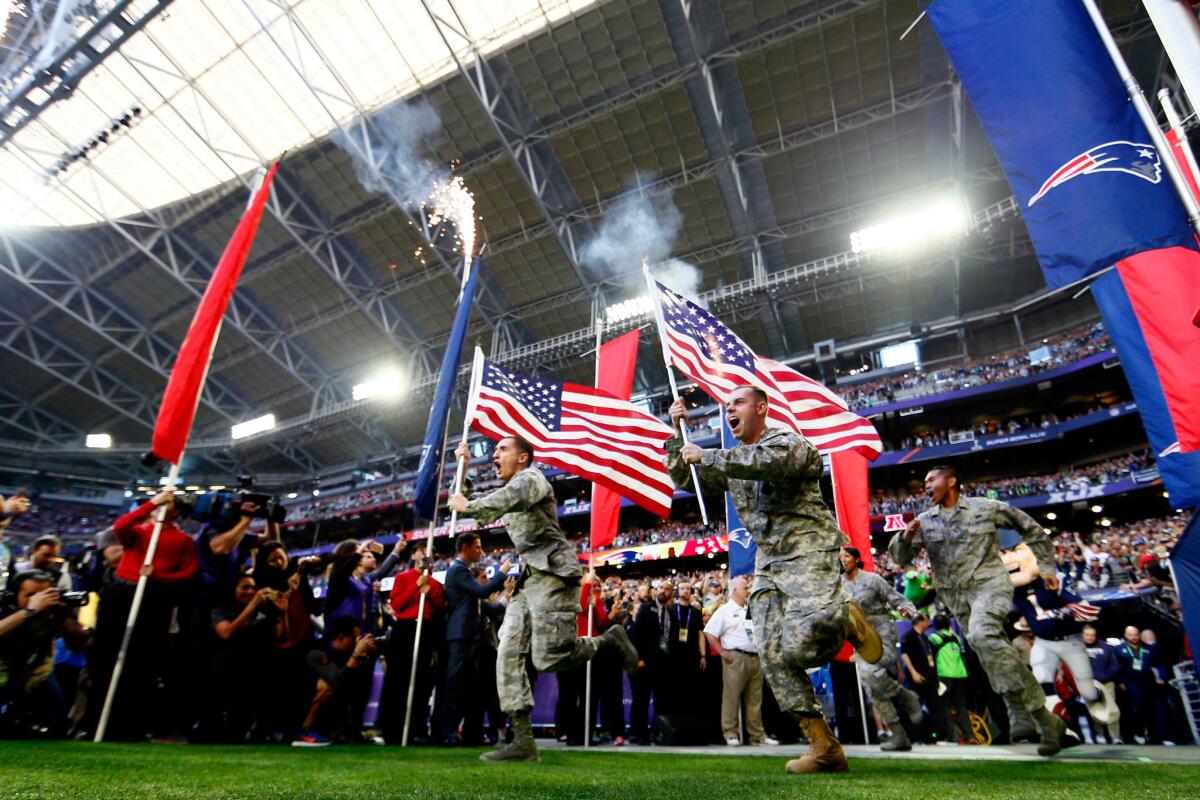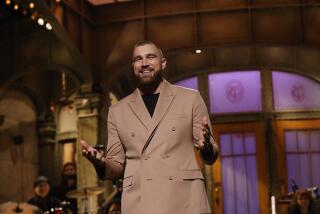Deals between National Guard and NFL cause a stir

Members of the United States military run onto the field prior to Super Bowl XLIX between the
- Share via
At halftime of each home game last season, the New England Patriots invited a soldier on the field to honor the troops. Dressed in camouflage, they smiled and waved to the crowd during the feel-good moment.
However, the “True Patriot” program wasn’t simply patriotism. It was part of a $225,000 advertising deal between the team and the Massachusetts and New Hampshire National Guard.
The military has long advertised at sporting events and during sports broadcasts as a way to reach potential recruits. But new revelations about deals between professional football teams and the National Guard have caused a stir over whether the military and the league should be more transparent about what’s a display of goodwill toward the troops and what’s a paid advertisement.
A report on government waste issued last week by Sen. John McCain (R-Ariz.) detailed the expenditure and questioned why the Guard spent $49.1 million on professional sports sponsorships in 2014. Some of that money funded programs by NFL teams similar to the “True Patriot” program that appeared to honor the military but were actually part of advertising agreements with the Guard.
“The Guard has claimed that states receive significant return-on-investment from these deals, but has provided no evidence to prove it,” McCain’s report said. “Using taxpayer funds to pay for the less tangible benefits of cobranding with billion-dollar sports leagues raises serious questions, particularly as the Guard reduces its end strength.”
The first item in a 12-point advertising agreement between the New York Jets and New Jersey National Guard for the 2012 season included a “Hometown Hero” feature. During each regular-season home game at MetLife Stadium, one or two soldiers would have their picture displayed on stadium video screens and their names announced over the public address system while they watched the game from the tony Coaches Club.
NJ.com first reported the arrangement, which netted the Jets $377,000 from 2011 to 2014.
Promoting the military is good publicity for any business these days. In the case of the NFL agreements, it was not clear that the military was paying for that publicity.
The Guard paid NFL teams $5.6 million in 2013 and 2014. This year, the Guard is spending $4.1 million on advertising through sporting events. That includes $1.2 million in payments to NFL teams. The Super Bowl-champion Patriots got the most at $225,000, with the Indianapolis Colts ($200,000) and Miami Dolphins ($160,000) close behind.
The nature of each team’s agreement with the Guard wasn’t clear. A Patriots spokesman didn’t return a request for comment.
A snow mobile race in Alaska got $200,000, as did a NASCAR track in Kansas. The NBA’s Boston Celtics got $70,000, the NHL’s Boston Bruins $130,000 and the North Carolina High School Athletic Assn. received $50,000.
------------
FOR THE RECORD
May 12, 3:45 p.m.: An earlier version of this article said the NBA got $70,000 in advertising from the National Guard. The $70,000 went to one team, the Boston Celtics, not the league.
------------
The Guard maintains the “advertising partnerships in order to increase awareness and consideration of service,” spokesman Maj. Earl Brown said. He noted that it has reduced spending on sports marketing by about 70% in the last two years, primarily by ending its $32.2-million sponsorship of NASCAR’s Dale Earnhardt Jr. and a $12.7-million deal with Indy car driver Graham Rahal in 2014 after questions by Congress.
“We have to be able to stretch our reach as far as we can,” Brown said.
The money covers a variety of advertising, including signs, scoreboard displays, recruiting booths in stadiums and promotions such as “high school game of the week.” And some of the deals bankroll the salutes to soldiers.
But while honoring soldiers, sailors and Marines has become commonplace at professional sporting events in recent years, military advertising as impetus for the heart-rendering displays appears limited to a handful of NFL teams.
The Washington Nationals, for example, play host to military members and their families in premium seats behind home plate for each game at Nationals Park. Injured soldiers, sailors and Marines receiving treatment at Walter Reed National Military Medical Center in nearby Bethesda, Md., have been frequent guests.
Nationals fans routinely give the service members a standing ovation when they’re introduced at the end of the third inning. The Nationals don’t receive payment for the salute, a team spokesperson said.
An NHL spokesman said that no money changes hands when a military member is spotlighted on the ice or in the stands at a game.
MLB is in the process of reaching out to clubs to understand the nature of their relationships with the military, chief communications officer Pat Courtney said.
“So far we have not found any club who is receiving payments from the armed forces in exchange for an in-game military salute,” he said.
The Angels and Dodgers salute military members during games, but work with nonmilitary sponsors.
Government records don’t show any advertising contracts between the military and Los Angeles-area teams from 2009 to present.
Times staff writers Helene Elliott and Bill Shaikin contributed to this report.
More to Read
Go beyond the scoreboard
Get the latest on L.A.'s teams in the daily Sports Report newsletter.
You may occasionally receive promotional content from the Los Angeles Times.












